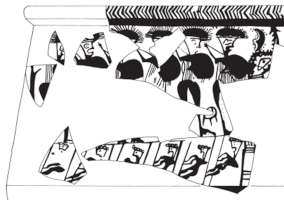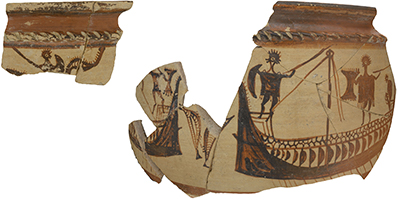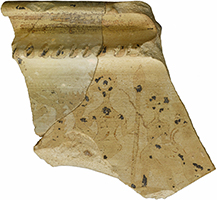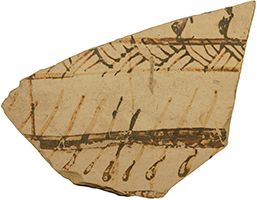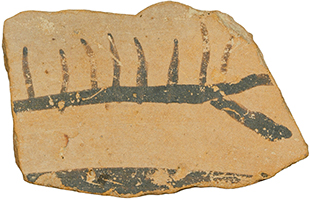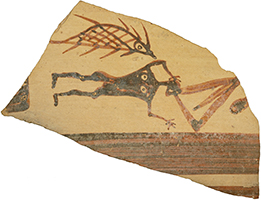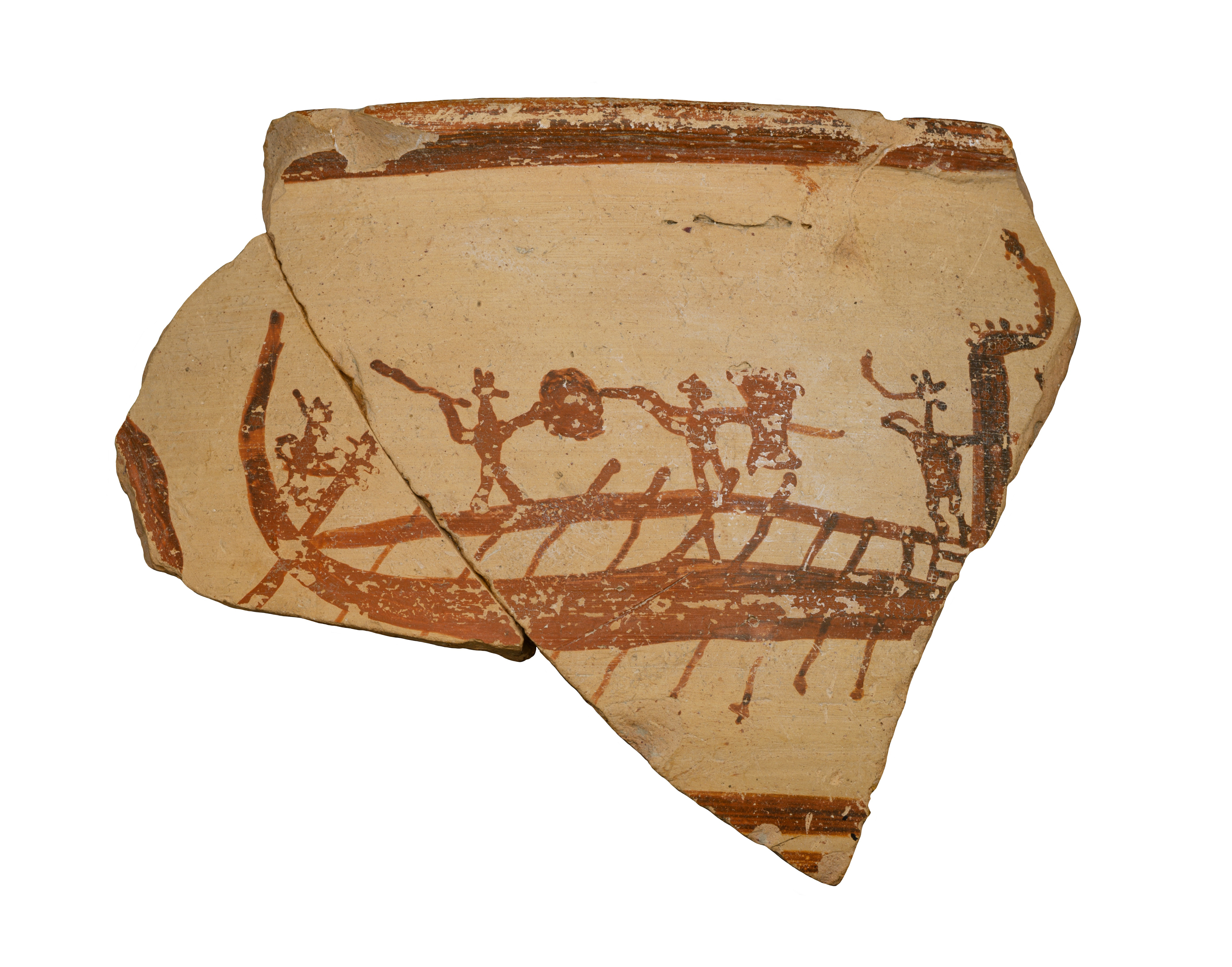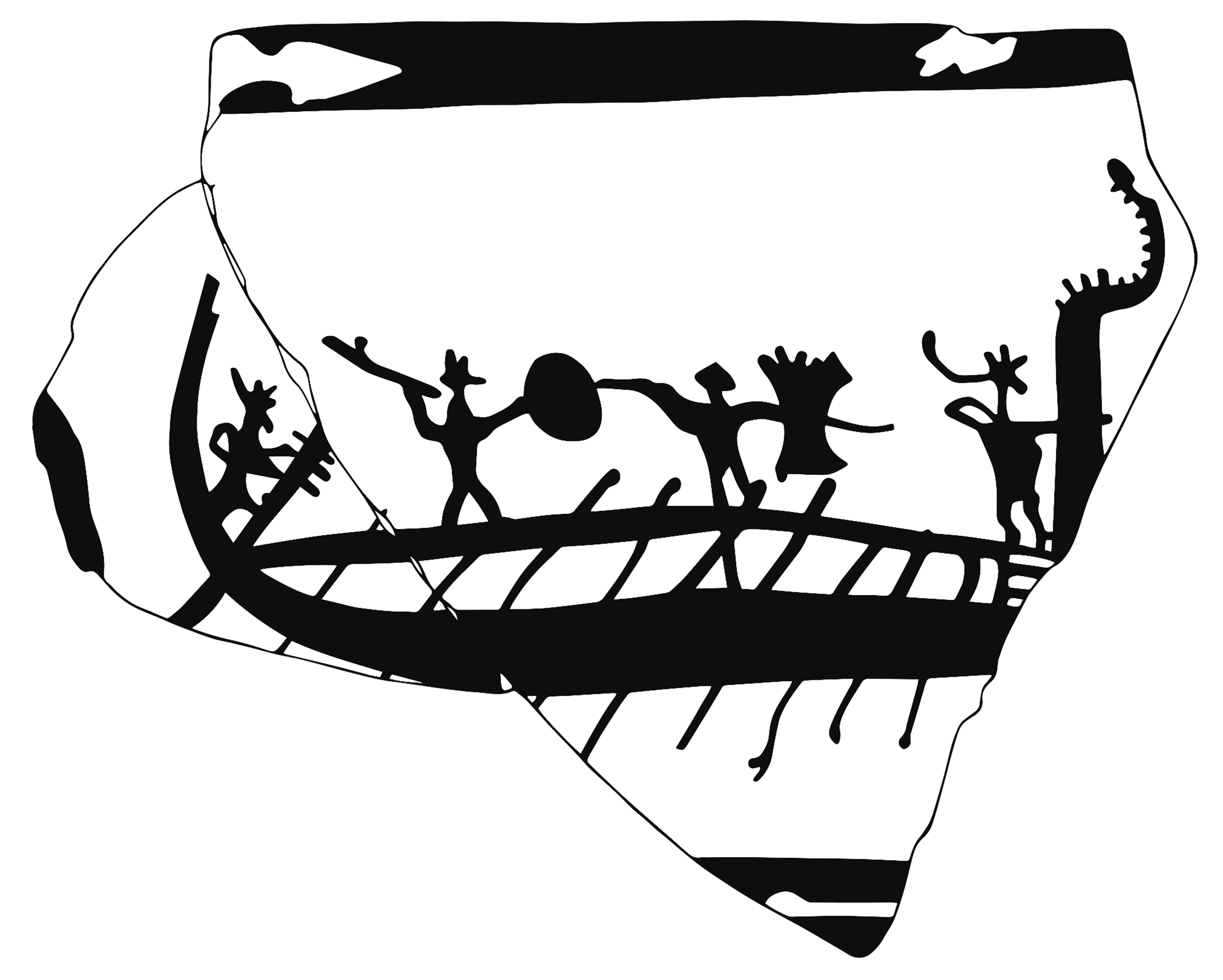Ship to the right, with a long narrow hull, curving sternpost and vertical stempost surmounted by a zoomorphic device identical to the one seen on (A91) but in more abstract form, without showing the eye. The hull is divided lengthwise into three different sections as with the first Kynos ship, except that the bulwark is open, possibly with its screen lowered. The warrior at the bow stands on a structure (forecastle) comprised of three vertical lines which are at the same level as the deck. The bird-headed device is again very similar, with a strongly recurving beak and twelve small projections from the inner side of its head and beak. The stanchions are omitted, probably to prevent confusion with the nine slanting oars. The galley's mast is retracted.
Naval combat scene
A92
LH IIIC middle
Pyrgos Livanaton (Kynos)
Sherd from a krater
Archaeological Museum of Atalanti K8990
Dakoronia 1990: 122, fig. 1; 1995: 147, fig. 1; 2002: 171, fig. 9; 2006a: 172, fig. 2; 2006b: 28, fig. 8; 2009: 278; Höckmann 2001: fig. 2; Karaminou 2002: 457, fig. 3; Knodell 2013: 377, fig. 6.5; Kramer-Hajos 2016: 152-153, fig. 7.2; Lemos 2014: 170, figs. 4c; Jung and Mehofer 2008: 133, fig. 9; Thomatos 2006: 248-249. Fig. 6.19 (20); Wachsmann 1998: 137; Wedde 2000: 330, no. 6002
Oared galley to the right, with three warriors, a helmsman, and nine oars. The warrior at the forecastle has his left arm extended forward and his right one drawn behind his head. Wachsmann interprets this to mean that he must be an archer handling a composite bow, as this gesture is conventional in many different cultures. The upper tip of the bow appears to be visible beneath the beak of the bird-headed stem. The other two warriors on deck are equipped with shields and javelins. Their gesture is identical to the warriors on the first Kynos ship - shield raised and javelin wielding arm extended backwards ready to throw. The same complement of round and Hittite type shields is shown, the latter having a fringed border. A helmsman working a single quarter rudder is shown at the stern.
This is the same type of ship as on the previous krater, except that it is executed by a less skilled hand. The recurving sternpost is similar to that of the Skyros ship. The way in which the stanchions are omitted is identical to the way in which warships are shown during the late geometric period, where they are absent in cases when the ship is depicted with the rowers working their oars from the lower level. The portrayal of the oars continuing up to deck level is considered by Wachsmann as unique within Mycenaean ship iconography. Such a development is highly significant because rowing these ships from the upper deck level was the first step toward the development of a two-banked vessel (dieres)(Wachsmann 1998: 155-56).
Dakoronia, F. 1990. “War-ships on Sherds of LH IIIC Kraters from Kynos,” in H. Tzalas (ed.) Tropis II: Proceedings of the 2nd International Symposium on Ship Construction in Antiquity, Delphi, 27, 28, 29 August 1987. Athens: Hellenic Institute for the Preservation of Nautical Tradition, pp. 117-121.
―――. 1995. “Republication of illustrations to Dakoronia 1987,” in H. Tzalas (ed.) Tropis III: Proceedings of the 3rd International Symposium on Ship Construction in Antiquity, Athens 24, 25, 26, 27 August 1989. Athens: Hellenic Institute for the Preservation of Nautical Tradition, pp. 147-148.
―――. 1996. “The Kynos…fleet,” in H. Tzalas (ed.) Tropis IV. 4th International Symposium on Ship Construction in Antiquity, Athens 1991. Athens: Hellenic Institute for the Preservation of Nautical Tradition, pp. 159-171.
―――. 2002. “Further finds from Kynos,” in in H. Tzalas (ed.) Tropis VII: Seventh International Symposium on Ship Construction in Antiquity, Pylos, 26, 27, 28, 29 August 1999. Athens: Hellenic Institute for the Preservation of Nautical Tradition, pp. 283-290.
―――. 2006a. “Bronze Age Pictorial Tradition on Geometric Pottery,” in E. Rystedt and B. Wells (eds.) Pictorial Pursuits : Figurative Painting on Mycenaean and Geometric Pottery. Papers from Two International Round-Tablw Conferences on Mycenaean Pictorial Pottery at the Swedish Institute at Athens in 1999 and 2001. Stockholm: Paul Åström Förlag, pp. 171-175.
―――. 2006b. “Mycenaean Pictorial Style at Kynos, East Lokris,” in E. Rystedt and B. Wells (ed.) Pictorial Pursuits: Eigurative Painting on Mycenaean and Geometric Pottery. Paper from Two International Round-Table Conferences on Mycenaean and Geometric Pottery at the Swedish Institute at Athens in 1999 and 200. Stockholm: Svenska Instituted I Athen, pp. 23-29.
―――. 2009. “Kynos’ Pace to the Early Iron Age,” in . S. Deger-Jalkotzy and A.E. Bächle (eds.) LH III C Chronology and Synchronisms III, LH III C Late and the Transition to the Early Iron Age: Proceedings of the International Workshop Held at the Austrian Academy of Sciences at Vienna, February 23rd and 24th, 2007. Wien: Verlag der Österreichischen Adademie der Wissenschaften., pp. 61-76.
Höckman, O. 2001. “The Kynos Sea-fighters: Exception of the Rule?” in H. Tzalas (ed.) Tropis VI: Sixth International Symposium on Ship Construction in Antiquity, Lamia, 28, 29, 30 August 1996. Athens: Hellenic Institute for the Preservation of Nautical Tradition, pp. 223-234.
Jung, R. and M. Mehofer. 2008. “A Sword of Naue II Type from Ugarit and the Historical Significance of Italian-type Weaponry in the Eastern Mediterranean,” Aegean Archaeology 8: 111–135.
Karaminou, D. 2002. “On the Form of Mycenaean Ships,” in H. Tzalas (ed.) TROPIS VII. Seventh International Symposium on Ship Construction in Antiquity, Pylos, 26, 27, 28, 29 August 1999. Athens: Hellenic Institute for the Preservation of Nautical Tradition, pp. 445-460.
Knodell, A. 2013. “Small-World Networks and Mediterranean Dynamics in the Euboean Gulf: An Archaeology of Complexity in Late Bronze Age and Early Iron Age Greece.” PhD Thesis, Brown University, USA.
Kramer-Hajos, M. 2016. Mycenaean Greece and the Aegean World: Palace and Province in the Late Bronze Age. Cambridge: Cambridge University Press.
Lemos, I.S. 2014. “Communities in transformation: An archaeological Survey from the 12th to the 9th century BC,” Pharos 20.1: 163-194.
Thomatos, M. 2006. The Final revival of the Aegean Bronze Age: a case study of the Argolid, Corinthia, Attica, Euboea, the Cyclades and the Dodecanese during LH IIIC Middle. Oxford: Archaeopress.
Wachsmann, S. 1998. Seagoing Ships & Seamanship in the Bronze Age Levant. College Station, TX: Texas A&M University Press.
Wedde, M. 2000. Towards a Hermeneutics of Aegean Bronze Age Ship Imagery. Peleus Studien zur Archäologie und Geschichte Griechenlands und Zyperns, vol. 6. Bibliopolis: Mannheim and Möhnsee.


